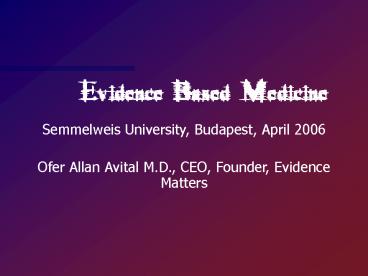Evidence Based Medicine PowerPoint PPT Presentation
1 / 10
Title: Evidence Based Medicine
1
Evidence Based Medicine Semmelweis
University, Budapest, April 2006 Ofer Allan
Avital M.D., CEO, Founder, Evidence Matters
2
Evidence Based Medicine (EBM) is the
conscious, explicit, and judicious use of the
best availalbe evidence to inform and improve
clinical decisions for patient care. Sackett
- 1996
3
- EBM is a process, which integrates
- the clinicians experience and judgement
- facts from the research evidence
- patient values and preferences.
- Without the first point, medicine becomes
cookbook practice, and is tyrannized by
external research, which may not apply in a local
setting or for a particular patient - Without the second point, there is a risk of
expertise deteriorating over time, to the
detriment of the patient - Without the third point, the patient will be
unsatisfied or will not co-operate
4
The Type of Question Determines Type of Evidence
If the Question is Relevant Research
Types Diagnostic Transverse Prognos
tic Cohorts Therapy (85) 10 levels
of evidence Systematic reviews
5
Why do we need Evidence-Based Medicine?
- Half of all medical knowledge is found to be
false every 5 years (Sackett 1997). i.e.
Half-life 5 years - Sackett found in a Canadian study that the choice
of antihypertensive medication was determined not
by patient factors (e.g. Level of diastolic blood
pressure, end-organ damage) but by the year of
graduation of the doctor! - To use new therapies, clinicians must keep up
with the scientific literature in a critical
manner
6
Why is it such a challenge to keep up?
- There are over 10,000 scientific journals
publishing over 2 millon medically-related
articles a year. - For a doctor to keep up in just his/her
specialty, the doctor would have to read 19
articles a day, 365 days a year! (Sackett 1997) - Not all the articles are scientifically valid,
or clinically relevant.
7
EBM offers a system for continuous
self-education, focused on the needs of your
patients 1. Convert the clinical information
need into an answerable question (P.I.C.O)
2. Retrieve a range of evidence in a systematic
manner 3. Critically evaluate the evidence 4.
Apply the results in clinical practice 5.
Evaluate the results for your patients!
8
Levels of Evidence for Research on Therapies
9
Critically Evaluating Evidence
- Chance How likely are the results due to
chance? What is the P value p-value
setting? What are the confidence intervals? - Systematic errors We can reduce these by
- a) Random assignment of patients to groups
- b) Blinding patients and clinicians to therapy
given. - Confounding Variables Try to control these
with - a) Randomized therapy assignment,
- b) Precise definitions of variables,
- c) Stratification analysis
- d) Multivariate analysis
- Many more...
10
Basic Bibliography
Daniel Friedland, in his book "Evidence-Based
Medicine. A Framework for Clinical
Practice" David L. Sackett "Evidence-based
Medicine. How to practice and teach EBM"

